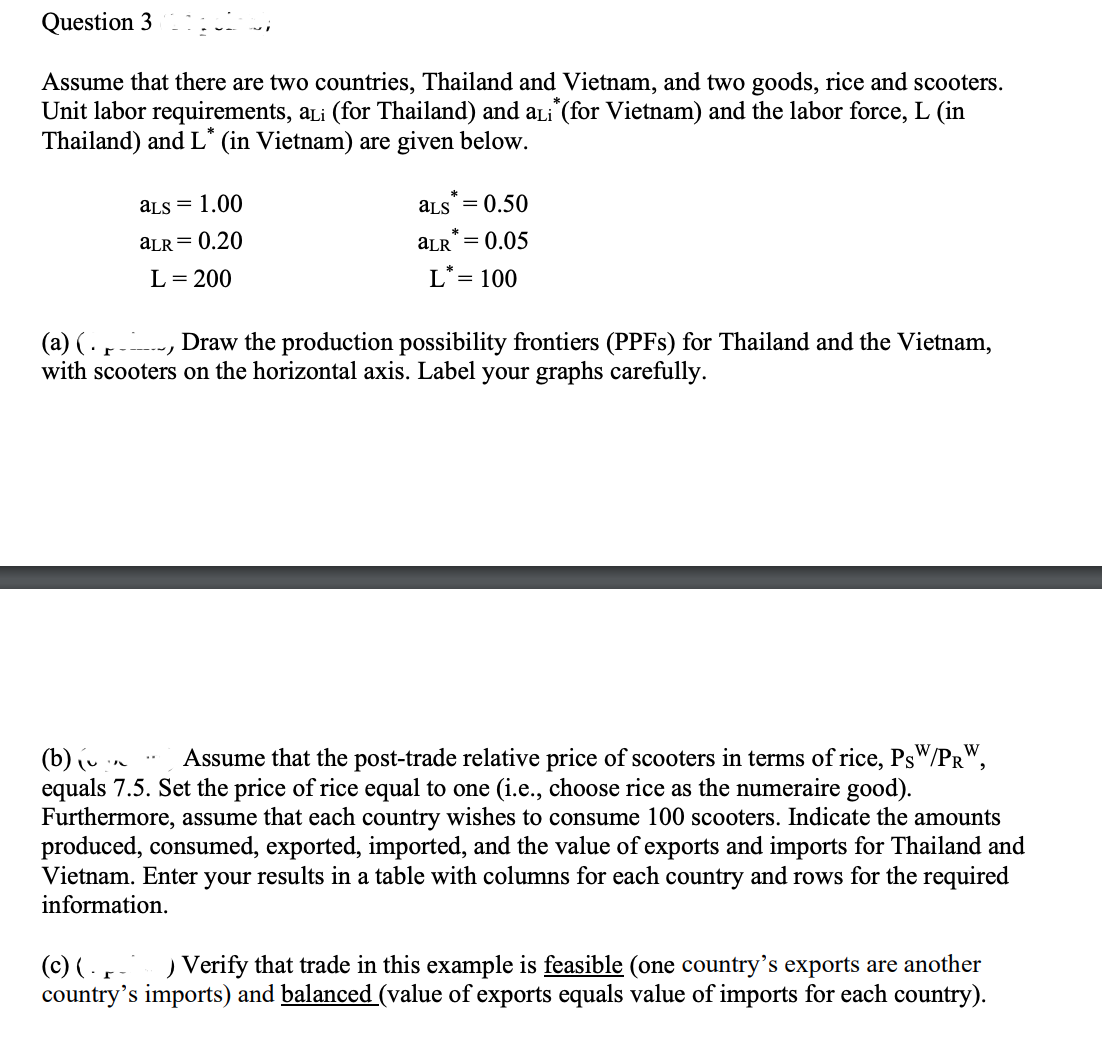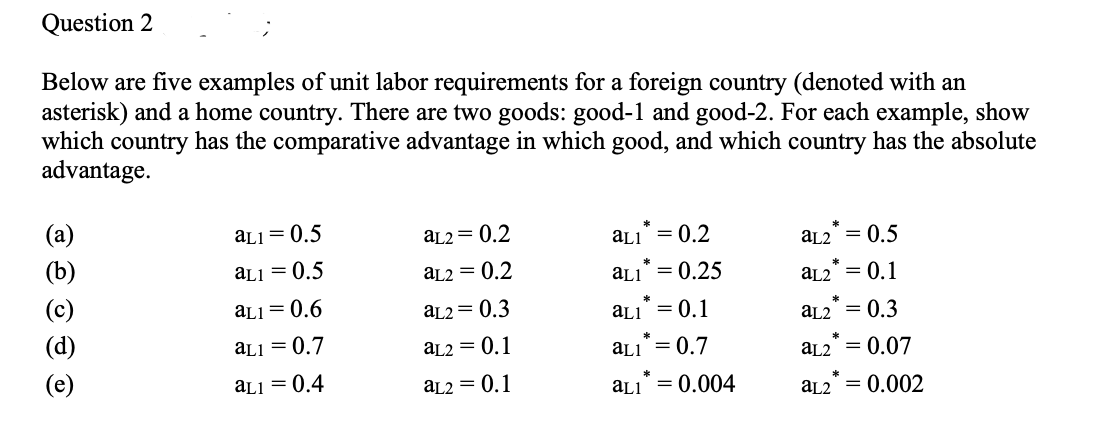Question 3 Assume that there are two countries, Thailand and Vietnam, and two goods, rice and scooters. Unit labor requirements, aLi (for Thailand) and aLi* (for Vietnam) and the labor force, L (in Thailand) and L* (in Vietnam) are given below. (a) ( аLS = 1.00 aLR = 0.20 L = 200 aLS = 0.50 = aLR 0.05 L* = 100 Draw the production possibility frontiers (PPFs) for Thailand and the Vietnam, with scooters on the horizontal axis. Label your graphs carefully. (b) (v Assume that the post-trade relative price of scooters in terms of rice, PsW/PRW, equals 7.5. Set the price of rice equal to one (i.e., choose rice as the numeraire good). Furthermore, assume that each country wishes to consume 100 scooters. Indicate the amounts produced, consumed, exported, imported, and the value of exports and imports for Thailand and Vietnam. Enter your results in a table with columns for each country and rows for the required information. (c) ( ) Verify that trade in this example is feasible (one country's exports are another country's imports) and balanced (value of exports equals value of imports for each country). Question 2 Below are five examples of unit labor requirements for a foreign country (denoted with an asterisk) and a home country. There are two goods: good-1 and good-2. For each example, show which country has the comparative advantage in which good, and which country has the absolute advantage. (a) aL1=0.5 aL2 = 0.2 (b) aL1 = 0.5 aL2 = 0.2 аL1 = 0.2 aL1 = 0.25 (c) aL2 = 0.5 aL2 = 0.1 aL1 = 0.6 aL2 = 0.3 аLI = 0.1 (d) aL2 = 0.3 aL1 = 0.7 aL2 = 0.1 aLI = 0.7 (e) aL2 = 0.07 aL1 = 0.4 aL2 = 0.1 * aL1 = 0.004 aL2 = 0.002
Question 3 Assume that there are two countries, Thailand and Vietnam, and two goods, rice and scooters. Unit labor requirements, aLi (for Thailand) and aLi* (for Vietnam) and the labor force, L (in Thailand) and L* (in Vietnam) are given below. (a) ( аLS = 1.00 aLR = 0.20 L = 200 aLS = 0.50 = aLR 0.05 L* = 100 Draw the production possibility frontiers (PPFs) for Thailand and the Vietnam, with scooters on the horizontal axis. Label your graphs carefully. (b) (v Assume that the post-trade relative price of scooters in terms of rice, PsW/PRW, equals 7.5. Set the price of rice equal to one (i.e., choose rice as the numeraire good). Furthermore, assume that each country wishes to consume 100 scooters. Indicate the amounts produced, consumed, exported, imported, and the value of exports and imports for Thailand and Vietnam. Enter your results in a table with columns for each country and rows for the required information. (c) ( ) Verify that trade in this example is feasible (one country's exports are another country's imports) and balanced (value of exports equals value of imports for each country). Question 2 Below are five examples of unit labor requirements for a foreign country (denoted with an asterisk) and a home country. There are two goods: good-1 and good-2. For each example, show which country has the comparative advantage in which good, and which country has the absolute advantage. (a) aL1=0.5 aL2 = 0.2 (b) aL1 = 0.5 aL2 = 0.2 аL1 = 0.2 aL1 = 0.25 (c) aL2 = 0.5 aL2 = 0.1 aL1 = 0.6 aL2 = 0.3 аLI = 0.1 (d) aL2 = 0.3 aL1 = 0.7 aL2 = 0.1 aLI = 0.7 (e) aL2 = 0.07 aL1 = 0.4 aL2 = 0.1 * aL1 = 0.004 aL2 = 0.002
Chapter1: Making Economics Decisions
Section: Chapter Questions
Problem 1QTC
Related questions
Question
please help me with question 2 and 3

Transcribed Image Text:Question 3
Assume that there are two countries, Thailand and Vietnam, and two goods, rice and scooters.
Unit labor requirements, aLi (for Thailand) and aLi* (for Vietnam) and the labor force, L (in
Thailand) and L* (in Vietnam) are given below.
(a) (
аLS = 1.00
aLR = 0.20
L = 200
aLS = 0.50
=
aLR 0.05
L* = 100
Draw the production possibility frontiers (PPFs) for Thailand and the Vietnam,
with scooters on the horizontal axis. Label your graphs carefully.
(b) (v Assume that the post-trade relative price of scooters in terms of rice, PsW/PRW,
equals 7.5. Set the price of rice equal to one (i.e., choose rice as the numeraire good).
Furthermore, assume that each country wishes to consume 100 scooters. Indicate the amounts
produced, consumed, exported, imported, and the value of exports and imports for Thailand and
Vietnam. Enter your results in a table with columns for each country and rows for the required
information.
(c) ( ) Verify that trade in this example is feasible (one country's exports are another
country's imports) and balanced (value of exports equals value of imports for each country).

Transcribed Image Text:Question 2
Below are five examples of unit labor requirements for a foreign country (denoted with an
asterisk) and a home country. There are two goods: good-1 and good-2. For each example, show
which country has the comparative advantage in which good, and which country has the absolute
advantage.
(a)
aL1=0.5
aL2 = 0.2
(b)
aL1 = 0.5
aL2 = 0.2
аL1 = 0.2
aL1 = 0.25
(c)
aL2 = 0.5
aL2
= 0.1
aL1 = 0.6
aL2 = 0.3
аLI = 0.1
(d)
aL2 = 0.3
aL1 = 0.7
aL2 = 0.1
aLI = 0.7
(e)
aL2 = 0.07
aL1 = 0.4
aL2 = 0.1
*
aL1 = 0.004
aL2
= 0.002
Expert Solution
This question has been solved!
Explore an expertly crafted, step-by-step solution for a thorough understanding of key concepts.
This is a popular solution!
Trending now
This is a popular solution!
Step by step
Solved in 2 steps with 1 images

Recommended textbooks for you


Principles of Economics (12th Edition)
Economics
ISBN:
9780134078779
Author:
Karl E. Case, Ray C. Fair, Sharon E. Oster
Publisher:
PEARSON

Engineering Economy (17th Edition)
Economics
ISBN:
9780134870069
Author:
William G. Sullivan, Elin M. Wicks, C. Patrick Koelling
Publisher:
PEARSON


Principles of Economics (12th Edition)
Economics
ISBN:
9780134078779
Author:
Karl E. Case, Ray C. Fair, Sharon E. Oster
Publisher:
PEARSON

Engineering Economy (17th Edition)
Economics
ISBN:
9780134870069
Author:
William G. Sullivan, Elin M. Wicks, C. Patrick Koelling
Publisher:
PEARSON

Principles of Economics (MindTap Course List)
Economics
ISBN:
9781305585126
Author:
N. Gregory Mankiw
Publisher:
Cengage Learning

Managerial Economics: A Problem Solving Approach
Economics
ISBN:
9781337106665
Author:
Luke M. Froeb, Brian T. McCann, Michael R. Ward, Mike Shor
Publisher:
Cengage Learning

Managerial Economics & Business Strategy (Mcgraw-…
Economics
ISBN:
9781259290619
Author:
Michael Baye, Jeff Prince
Publisher:
McGraw-Hill Education